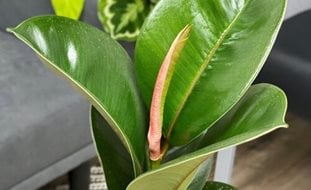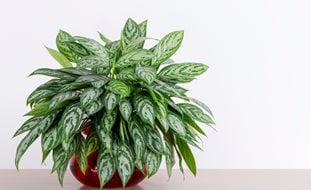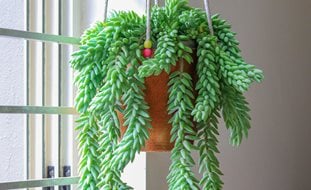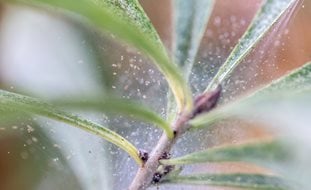15 Rare Houseplants Anyone Can Grow
Looking for a unique specimen to add to your houseplant collection? Try one of these intriguing options. Published 10/13/2022Whether you're an avid houseplant collector in search of the latest “it” plant or just a casual houseplant grower who wants to venture beyond the commonplace, you can find a wide variety of rare and unusual houseplants that will satisfy your quest for something different.
Many “rare” houseplants are simply new twists on common houseplants you are already familiar with, such as philodendron or snake plant. These cultivars are highly sought after for their one-of-a-kind features, like fascinating leaf shapes, bold color variations, and unusual growth habits. But just because these plants look exotic doesn’t mean they are harder to care for than other houseplants. As long as you meet their basic needs, most of these rare gems will thrive indoors with very little pampering.
Featured in: Garden Design's Top 9 Garden Trends for 2023 ("Expanding Houseplant Collections")
LILY PADS™ UMBRELLA FIG TREE (Ficus umbellata)
Height: 24 to 72 inches
Light: Bright light with some direct sun, such as from east- or west-facing window.
Water: Water when the top inch or two of soil feels dry to the touch. Avoid letting it dry out completely.
Humidity: Prefers high humidity
Distinctive feature: Large olive-green leaves that look like lily pads
Related to the fiddle leaf fig, but less finicky and troublesome. For optimal performance, grow in a warm room (60° to 85° F) and avoid drafty areas near heating and cooling vents. Although this tropical beauty can handle some direct light, avoid scorching afternoon sun, which can cause leaf browning.
MYTHIC™ SILVER DRAGON JEWEL ALOCASIA (Alocasia baginda)
Height: 1 to 3 feet
Light: Bright indirect light; keep away from direct sunlight.
Water: Water regularly to keep the soil evenly moist, or whenever the top layer of soil feels dry to the touch.
Humidity: Prefers high humidity
Distinctive feature: Deeply veined green leaves with a silvery sheen
Jewel alocasias are prized for their deeply veined leaves, which come in an assortment of striking patterns and colors. These rainforest natives are happiest when grown in a humid environment. In drier areas of the home, keep your plants hydrated by using a humidifier or misting the leaves regularly. Learn more about how to grow alocasia plants.
PRISMACOLOR™ FERN-LIKE PHILODENDRON (Philodendron mayoi)
Height: 2 to 4 feet
Light: Low to bright indirect light
Water: When the top inch or two of soil feels dry. Do not allow to dry out completely.
Humidity: Prefers high humidity
Distinctive feature: Deeply cut fern-like foliage
Here’s a philodendron that truly stands apart from the rest, with huge, glossy green leaves that become increasingly lobed as they grow larger (photo is of a younger plant). It can tolerate low light levels, too, making it a great choice for dimly lit rooms. Learn more about how to grow philodendron plants.
MYSTERIA™ ADANSONII™ MINI SWISS CHEESE VINE (Monstera adansonii)
Height: Climbs 6 to 8 feet
Light: Low to medium indirect light
Water: Water when the top inch or two of soil feels dry.
Humidity: Prefers high humidity
Distinctive feature: Glossy green leaves with natural holes
This magnificent houseplant resembles Monstera deliciosa but has perforated leaves that look like slices of Swiss cheese. The leaves get larger over time, so be sure to provide a good support structure, such as a moss pole, that the plant’s aerial roots can cling to. Learn more about how to grow monstera plants.
RAVEN® ZZ PLANT (Zamioculcas zamiifolia 'Dowon')
Height: 2 to 3 feet
Light: Low to bright indirect light; keep out of direct sunlight, which can scorch the leaves.
Water: Every two weeks, or when the top inch or two of soil feels dry.
Humidity: Prefers average humidity
Distinctive feature: Glossy, nearly black leaves
One of the newest and most dramatic ZZ varieties, with leaves that emerge a bright lime-green color and gradually turn a deep purple, almost black, shade as they mature. Not only do ZZ plants tolerate low light and little watering, they can go for weeks without fertilization. Learn more about how to grow ZZ plants.
CEBU BLUE POTHOS (Epipremnum pinnatum)
Height: Trails or climbs up to 9 feet
Light: Medium to bright indirect light
Water: When the top inch or two of soil feels dry; can tolerate some dryness between waterings.
Humidity: Prefers average humidity
Distinctive feature: Blue-green foliage
A cousin of the common pothos (Epipremnum aureum), and just as easy to grow, but with extraordinary silvery blue leaves up to 7 inches long. For the best foliage color, grow in bright indirect light. The color may fade when grown at lower light levels. Learn more about how to grow pothos plants.
ART DECO™ DROP TONGUE PLANT (Schismatoglottis wallichii)
Height: 12 to 24 inches
Light: Bright indirect light
Water: When the top inch or two of the soil feels dry. Use a well-draining potting mix.
Humidity: Prefers average humidity
Distinctive feature: Highly decorative variegated foliage
This exotic rainforest native features heart-shaped green leaves adorned by icy streaks of silver. Compact enough to display on a desk or tabletop, it’s also fairly easy to grow, making it a great houseplant for beginners.
COLOR FULL® BEAUTY STAR PRAYER PLANT (Calathea ornata)
Height: 12 to 36 inches
Light: Low to medium indirect light, avoiding direct midday sun. The leaf markings will be less distinct in low light.
Water: Keep soil moist but not overly wet, watering whenever the top inch or two of the soil feels dry.
Humidity: Prefers high humidity
Distinctive feature: Boldly striped green and white foliage with burgundy undersides.
Also known as zebra plant because of its colorful striped foliage, Calathea has leaves that fold up at night like hands in prayer. This tropical native thrives in greenhouse-like conditions, so place in a bathroom, kitchen or other humid location. It will also grow well in a closed terrarium. Learn more about how to grow calathea plants.
STRING OF TURTLES PEPEROMIA (Peperomia prostrata)
Height: Trails up to 12 inches
Light: Bright indirect light, such as from an east- or west-facing window.
Water: Every seven to ten days, or when the top inch or two of soil feels dry.
Humidity: Prefers moderate to high humidity
Distinctive feature: Patterned leaves that look like turtle shells
An unusual vining variety with fleshy, succulent green leaves adorned with a distinctive shell-like pattern. Because of its succulent-like qualities, this easy-care plant can go a week or longer between waterings. Like most peperomia, it is easy to propagate from stem cuttings. Learn more about how to grow peperomia plants.
CHROMA® BELIZE RUBBER PLANT (Ficus elastica)
Height: 4 to 10 feet
Light: Moderate to bright light, with some direct sun. Will not tolerate low light.
Water: When the top 2 to 3 inches of soil feels dry.
Humidity: Prefers moderate to high humidity
Distinctive feature: Multicolored leaves flushed with pink and cream
Although rubber plants with glossy, dark green leaves are fairly commonplace, it’s much harder to find varieties with variegated foliage. Under the right conditions, this lush indoor tree can grow to ceiling height. For a bushier plant, prune off the top at the central stem to encourage side branching. Learn more about how to grow rubber plants.
LIVING LACE® DAVANA BLUE STAR FERN (Phlebodium aureum)
Height: 10 to 14 inches
Light: Low to medium indirect light.
Water: Keep soil evenly moist, watering as soon as the soil surface feels dry. Never allow to dry out completely.
Humidity: Prefers high humidity
Distinctive feature: Ruffled, scalloped arching fronds
An evergreen rabbit's foot fern with ruffled, scalloped fronds that turn powdery blue-green, adorned with yellow-orange spore cases, and has furry rhizomes that produce new leaves.
XEROGRAPHICA AIR PLANT (Tillandsia xerographica)
Height: Up to 3 feet across
Light: Medium to bright indirect light
Water: Submerge in room temperature water once a week, turning it upside down after soaking to allow excess water to run off.
Humidity: Prefers high humidity
Distinctive feature: Silvery, almost white, curling leaves
Tillandsias are super easy to care for because they collect water and nutrients from the air through their leaves and need no soil to grow (although you still need to water them on occasion). Instead of putting them in a pot, display them in a pretty glass bowl or on a decorative piece of wood to create a fascinating centerpiece.
WHALE FIN SNAKE PLANT (Dracaena masoniana)
Height: 2 to 3 feet
Light: Low to bright indirect light
Water: Once every week or two, or when the soil has fully dried. Avoid overwatering.
Humidity: Can tolerate a wide range of humidity levels.
Distinctive feature: Wide, paddle-like leaves
Although snake plant is well known for its tall, sinuous foliage, this variety breaks the mold with extra-wide leaves that can grow over a foot across. You can also find a gorgeous variegated version (Dracaena masoniana 'Variegata') with pale yellow and green vertical striping. Learn more about how to grow snake plants.
PRISMACOLOR™ SILVER SWORD PHILODENDRON (Philodendron hastatum)
Height: Trails or climbs 3 to 10 feet
Light: Bright filtered light, preferably with some early morning or late afternoon sun.
Water: Water when the top inch or two of soil feels dry. Do not allow to dry out completely.
Humidity: Prefers high humidity
Distinctive feature: Deeply lobed silvery gray leaves
This vining jungle aroid is grown for its unique, silvery gray foliage. Like many philodendrons, this plant is a climber, so be sure to give it a moss pole, trellis, or some other support for the roots to attach to as the plant grows. Learn more about how to grow philodendrons.
TIPS FOR BUYING RARE HOUSEPLANTS
- Although you might have a harder time tracking down rare houseplants than more commonplace varieties, they are by no means impossible to find. Try local garden centers or reputable online plant stores. (Find local retailers of Proven Winner’s leafjoy® houseplants.)
- As you might expect, rare houseplants often carry a higher price tag, so be aware of any guarantees regarding the health and quality of the plant, as well as any refund policy—especially if a plant ordered online arrives damaged.
- Many rare houseplants are tropical natives with very particular growing requirements, so do your research first. Does your home have enough light or humidity to keep your prized plant healthy? If you tend to be forgetful about watering or fertilizing, will the plant be able to tolerate a bit of neglect?
- Once you acquire a healthy rare houseplant, protect your investment by following its care requirements to the letter, not only for watering, fertilizing, and light, but also for minimum room temperature, the best type of potting soil to use, pruning, and pest control.




















